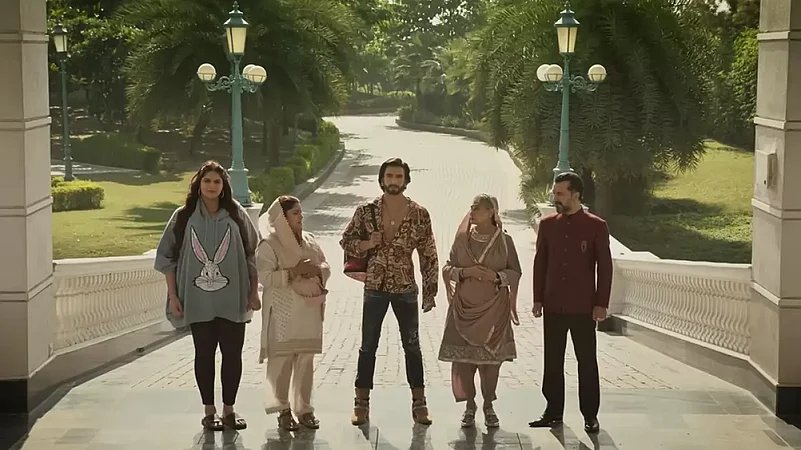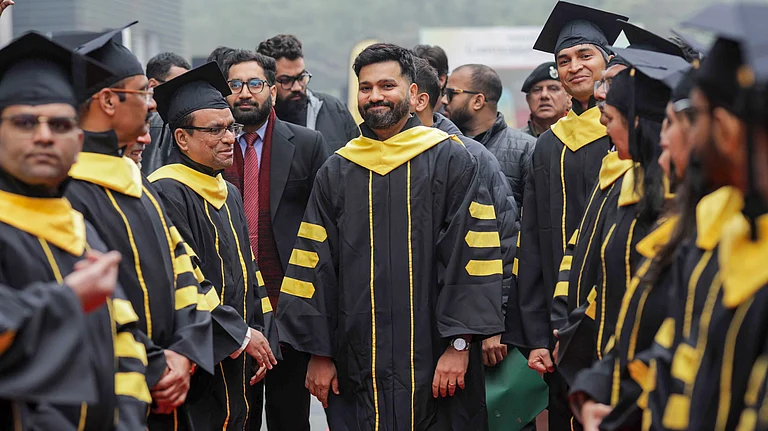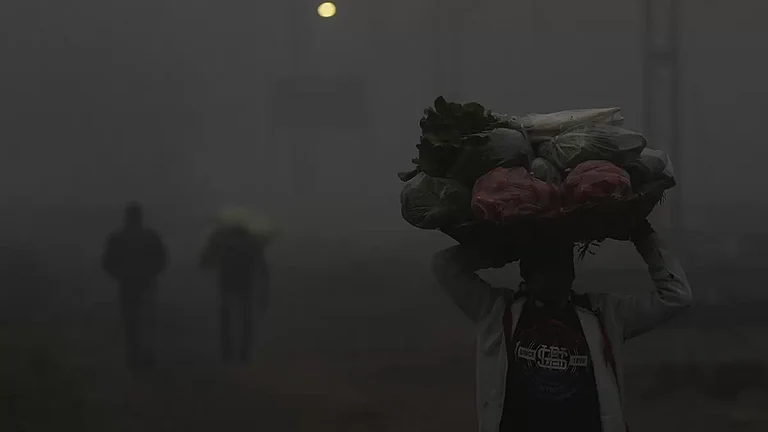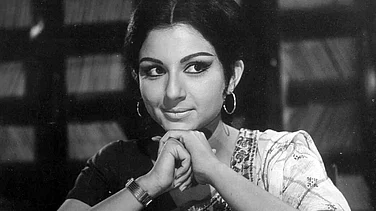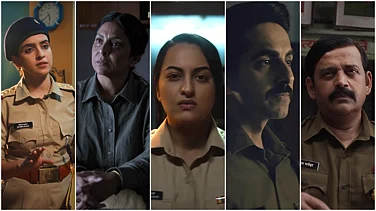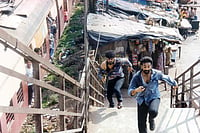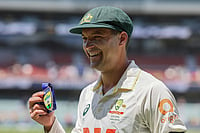ROCKY AUR RANI KII PREM KAHAANI
Directed by Karan Johar
2 hours 48 mins
OMG 2
2 hours 36 mins
Directed by Amit Rai
After seeing two films on two consecutive days in Mumbai, it appears that some things have changed in the cinema of Bombay. In the larger world where we live our real lives, the winds of change have been blowing for decades. In a world that has become much more connected, the impact has gone beyond mere fashion to making us question how we have been in our innermost lives.
It used to be that the elite, exposed to ‘foreign’ lands and cultures, would bring that into our mainstream cinema, in a copycat manner, with the way heroes and heroines dressed, or with the musical trends in song and dance. Today it is not just the elite; society at every level has been affected, and the emotional and intellectual distance from the rest of the world has shrunk. Everyone is seeing more of the world up close. This has thrown up contradictions, to which one response has been to take refuge in traditional belief systems,
ignoring all else; the other has been to reconcile these with modern life. A third has been to embrace change and leave the past behind.
But our mainstream cinema had created a bubble in which it continued to exist and thrive. Even films made with fresh styles and stories, from DDLJ to Jab We Met, were operating on the surface, evading the real issues. The exceptional filmmakers from an earlier era—such as Raj Kapoor, Guru Dutt, Bimal Roy, and Hrishikesh Mukherjee—had shown an acute understanding of realities in their movies. They had engaged with the times while making entertaining films. But no one seemed to take inspiration from them and attempt to engage deeply. Somewhere along the line, the cinema of Bombay lost its connection and presented a woefully distorted picture of the times, with occasional exceptions.
Now something seems to have stirred the pot. The cinema of Bombay (I use this phrase in preference to Bollywood) seems to have woken up from its long sleep. These two recent films, with big studio backing, suggest this. There is a forthrightness about these films that redeems them from the weaknesses of the narratives one has seen countless times, which they do not altogether leave. But they do take head-on the contradictions we find ourselves in.
The two films are different in style and content, and set in very different worlds, yet they share a theme. And in one word, that theme is repression. Both films are responses to repression in the family. One takes up the subject of sexual repression (while talking about the need for ‘sex education’), and the other takes up women’s repression (while it does even things out in the end by making it about parental repression of both daughters and sons.) Both proceed without flinching at any point. They are thus courageous works which have been carefully thought out. This is admirable.
Rocky Aur Rani Kii Prem Kahani (RRKPK) begins in an unspectacular way, with the usual spectacle. A routine song and dance number performed by Rocky (Ranveer Singh). What comes next is a voiceover-led introduction of the Dhanalakshmi House that will become the centre of the drama for the rest of the film. Soon comes the central plot, rather two simultaneous plot lines. Anurag Basu introduced the idea of ageing heartthrobs (Dharmendra and Nafisa Ali) yearning to reunite with the love of their younger selves, one of the memorable stories in his beautiful film Life in a… Metro. That idea is taken further and becomes a driving force here, in a track that runs parallel to Rocky and Rani’s love story.
The film also repeats the idea of two cultures in conflict – done several times earlier – here it is the Punjabi family versus the Bengali family. It is mined for laughs, based on stereotypes, which is precisely the reason to play the routine. But one must note that it is done with nuance and feeling, too, and that shows an attempt to break out of the stereotyping that movies, including this one, have been doing. There is meta in mainstream, how cool is that. In many ways, which makes it so interesting, the film– or the film’s maker as films don’t come made on autopilot – questions its own logic.
For one family it is all about business and money; for the other, it is all about art and culture. In a nice touch, the patriarch of the Punjabi family, Kanwal Randhawa (Dharmendra), is not a dominating brute; he happens to be a person ruled by his heart, in love with shayari and Jamini (Shabana Azmi). And therefore, he is shunned by the Family, which is ruled by the stern matriarch Dhanalakshmi (Jaya Bachchan). His son, cleverly named Tijori, does the mother’s bidding and stays away from the father. These characterisations are richly explored. Karan Johar is masterful at bringing out into the light all the pain, scars and wounds that hide unseen in family relations.
Karan Johar’s tribute to film songs is charmingly done. One can sense his genuine love for them — among them an all-time classic, Chaudhvin Ka Chand Ho and the new classic, Mun dola re dola re dola. Nazia Hassan’s Aap jaisa koi also finds a place.
The love story of Rocky and Rani is, again, nothing new. It is the familiar idea of opposites attract, used time and again in movies for the simple reason that it provides an easy way of engaging us in drama. It is expedient, not that anyone believes in it. Interestingly, the film itself confronts this idea, but only for a while. It falls back eventually on the familiar resolution of such a story— how the heart matters, how a silly person is also great because he has a heart of gold, et cetera. No amount of meta helps here. In the characterisation of the alpha male, the film is regressive. Soch nayi par swaad wahi, a catchline in the film sums it up, ironically.
In this respect, our mainstream cinema still has a long way to go to bring genuine love stories on screen. How many more decades before that happens? Presenting the leading woman (Alia Bhatt) who can look at a relationship in a very practical and unemotional way and stand up to bullying men of all stripes is a good start. That the film continues to hold its ground on women is remarkable. It would have been easy to capitulate, and make a bigger box-office hit by doing that, by presenting the women as submissive to men in the end.
OMG 2 is a more daring film in many ways. It walks into its subject with confidence and what one may even call a sense of bravado. It is set in a middle-class world, an ordinary family in small town India, not the ultra-rich class you only see in movies from Mumbai, such as RRKPK. The central character is Kanti Sharan Mudgal (Pankaj Tripathi), a man of modest means; he rides a scooter and is humble in his dealings with the world, unlike the uber alpha male of a business family in RRKPK who likes to dominate every scene and show off his body and his Ferrari at every turn. (RRKPK perpetrates the myth that such a man is attractive to a young woman. Do the makers seriously believe this?) But OMG 2 also suffers from employing a luxury sports car as a symbol of power, here of the divine Shiva (Akshay Kumar), which is quite bizarre.
What is this strange obsession with fast cars in our movies? Is it just the fact that the superstar actors love them, and it is assumed everyone would admire them for it? Hasn’t the rest of the world gotten over this fixation with cars? When will we move on from this idea of a previous era? On the other hand, the Nandi bull following him is a much more interesting touch, and it brings a smile every time it appears, with the bells tinkling.
Pankaj Tripathi plays it perfectly. He does nothing in excess just because he is the lead character. It takes absolute confidence as an actor to be able to do that. As a priest in a Shiva temple, he has to face social ostracization because his teenage son was caught on camera masturbating in the school’s toilet. That’s it. On this slim premise, Amit Rai sets out to weave an entire movie, that too as a courtroom drama, and surprisingly succeeds. The film somehow remains watchable, though there are moments when you feel it has become overdrawn.
To marshall his arguments, Pankaj turns to ancient texts, which is logical considering that he is a priest. The literature he digs up leads him to point to Konark and Khajuraho as evidence and exhibits in the courtroom. He asserts that the unabashed depiction of sex in a religious setting was not seen as a contradiction in ancient India. We were free of this guilt that sex is something to hide or be ashamed of. He even brings up the Kama Sutra, which ‘the world has been reading up’ while teaching us ‘morality’. The colonial past is brought up to explain why these attitudes prevail. Interestingly, there is an extended scene of going out to buy a bra in RRKPK. It strikes at a similar inhibition— talking about female body parts in a normal way that does not degrade or unnecessarily sexualize them.
At a nine-thirty pm show, there were men and women, young and middle-aged in equal numbers, all looked absorbed with the film. The film has struck a chord. The middle class in which it is set is also its primary audience. Some would say, ‘why bring up a divine being for such a simple matter? They did it for box-office’. The extravagant song, yes. But in the story? I am not sure. I think it is needed. We do look up to the Divine even in the most minor troubles, and the powerless Kanti Sharan Mudgal, facing a hostile world, needs that magical intervention to keep going. And Akshay Kumar carries it off with grace, calm and cool.
I think these two films could be a turning point in our mainstream cinema. In taking up everyday subjects, probing without flinching, questioning accepted notions, being sensitive and courageous, and all the while keeping the audience entertained. They are certainly better than all the exploitative films that depend on violence and demeaning portrayals of women to propel their unimaginative stories. These two are made from the heart, with a good deal of thought. It is a moment to watch. Whether it will become a moment of reckoning, time will tell.






